Honda SCL500 / CL500 (2023+) Maintenance Schedule and Service Intervals
This is the Honda CL500 (known as the Honda SCL500 in the USA when released) maintenance schedule from the manual, plus notes from parts references and service manuals.
The Honda CL500 is a sport standard in the “scrambler” style, with comfortable swept-back bars, a flat seat, and a high-mounted exhaust.
The heart of the Honda SCL500 / CL500 is the same as the Honda CB500 series, including (for example) the Honda CB500F. It’s a 471cc liquid-cooled parallel twin engine that makes peak power of 34.3 kW at 8500 rpm. With its mild 10.7:1 compression ratio, it runs on regular gas, which helps with economy even more!
Final drive is via a slipper clutch, 6-speed box, and chain.
Updated 2 Oct 2023 with chain maintenance information and suspension adjustment guidelines
This site has links from which we earn a commission (which unfortunately nobody can save, not even us). If you appreciate this research work, then please use those links. Thanks.
Honda SCL500 / CL500 Service Intervals
Aside from the break-in service, the service interval for the Honda SCL500 / CL500 is every 8 000 miles / 12 000 km or annually, at which point you change the engine oil and check for leaks, worn components, or things in need of lubrication.
Honda also recommends some service between scheduled services, mostly for safety (brakes, clutch) and emissions equipment.
The major service for the Honda SCL500 / CL500 is every 16 000 miles / 24 000 km, at which point you change the oil filter and spark plug and check the valve clearances. The CL500 has a parallel twin with four valves per cylinder, so the checks are relatively simple, especially considering it’s a naked motorcycle with easy access.
Air filters changes are between, or more often if you ride the bike in dusty or wet areas, which you might do if you actually do any scrambling.
Make sure to keep the brake fluid and the coolant up to date, and to maintain the chain of course.
There’s more detail in the full maintenance schedule below.
Honda SCL500 / CL500 Maintenance Schedule
Below is the maintenance schedule for the Honda SCL500 / CL500.
The schedule is presented in simplified format vs the manual to break out some items and make it easier to parse. Also, the order has been changed to put the most important things (e.g. oil changes) up top.
Frequent / Inter-service inspections:
Do the following inspections every 4000 miles / 6000 km, i.e. between services.
| Honda SCL500 / CL500 Frequent Inspection Checklist |
|---|
| [Dealers] Honda Diagnostic System — Perform check |
| Brake fluid — Inspect level Inspect regularly — Pre-ride |
| Brake Pads — Check wear level Inspect regularly — Pre-ride |
| Clutch system — Inspect correct function |
Service Schedule
Notes:
- At the end of the maintenance schedule, keep following it in the pattern shown (following services every 8 000 miles / 12 000 km, with minor checks in between)
- The break-in service is omitted below (the dealer usually does this in the warranty period, and it’s just an oil/filter change plus a number of checks for leaks, lubrication etc.)
- Honda generally recommends you take your motorcycle to a dealer for servicing the wheels/tyres, steering, spark plug, and valves, but other things are possible to be done by a competent home mechanic.
Important note: The US and European manuals differ slightly. The US manuals specify 12 800 km intervals, whereas the European ones say 12 000 km / 8000 miles. Since the US doesn’t use km, I’ve included the rounder European values below.
| mi x 1000 | 8 | 16 | 24 | 32 | |
|---|---|---|---|---|---|
| km x 1000 | 12 | 24 | 36 | 48 | Every |
| Inspection checklist — Perform (see below) | ✓ | ✓ | ✓ | ✓ | Year |
| Engine Oil — Replace (Pro Honda GN4 10W-30) | ✓ | ✓ | ✓ | ✓ | Year |
| Engine Oil Filter — Replace (HF204RC) | ✓ | ✓ | |||
| Air Filter — Replace (HA-2513) | ✓ | ✓ | Service more often when riding in wet or dust | ||
| Spark plugs — Replace (NGK CPR8EA-9) | ✓ | ✓ | |||
| Valve Clearances — Check / adjust | ✓ | ✓ | |||
| Brake Fluid — Replace (Use Honda DOT 4) | 2 years | ||||
| Coolant — Change (Pro Honda HP Coolant) | 3 years | ||||
| Secondary Air Supply System — Inspect | ✓ | ✓ | |||
| Evaporative Emission Control System — Inspect | ✓ | ✓ |
Standard Inspection Checklist
Do the following checks on your Honda CL500 as part of every scheduled inspection.
| Honda SCL500 / CL500 Inspection Checklist |
|---|
| Fuel Lines — Check condition, correct routing, and for no cracks |
| Throttle operation and free play – Lubricate with Protect all cable life Target free play: 2-4 mm (0.1-0.2 in) |
| Check engine idle speed Target: 1200 rpm +/-100 |
| Coolant — Check level |
| Cooling system — Check for no leaks, and that fans come on |
| Drive chain slider — Check wear level. Replace as necessary |
| Clutch system — Check for correct function, and clutch free play |
| Brake system — Check for proper function |
| Brake light switch — Check lights come on |
| Wheels/Tires — Check for dents, tire condition, tread depth |
| Suspension — Check for smooth operation, no leaks |
| Headlight aim — Check, re-adjust after adjusting suspension |
| Side stand — Check for smooth function, lubrication condition |
| Steering head bearings — Check for smooth operation |
| Nuts, bolts, fasteners — Check for presence. Replace / retighten as needed |
| Secondary air supply system — Check |
| Crankcase breather (if fitted) — Check, clean as needed |
Honda SCL500 / CL500 Chain Maintenance
The Honda SCL500 / CL500, being a Scrambler-style motorcycle, is a bike you’re going to be using to do wheelies in deserts! Well, you’ll be dreaming about it, anyway. As a result of those dreams, it’s important to keep your chain clean, lubed, and correctly tensioned.
Honda recommends you follow the following chain maintenance schedule:
| Chain maintenance item | Every |
|---|---|
| Check drive chain lubrication condition, lubricating if necessary — but do so more often if your ride your CL500 in dirty or rainy conditions | 600 mi / 1000 km |
| Check drive chain slack, adjusting if necessary Target chain slack — 30-40mm (1.2-1.6 in) | 600 mi / 1000 km |
Honda defines chain slack for the SCL500 / CL500 as free vertical play of the chain when you push it up and down. (Some brands/motorcycle manuals define it as distance from the chain slider.)
Measure chain slack when the motorcycle is on its side stand, with no load on it, in neutral, and on a level surface.
Check the slack on the lower part of the chain, midway between the sprockets, and check it in multiple places (move the motorcycle forwards and backwards) as chains wear unevenly.
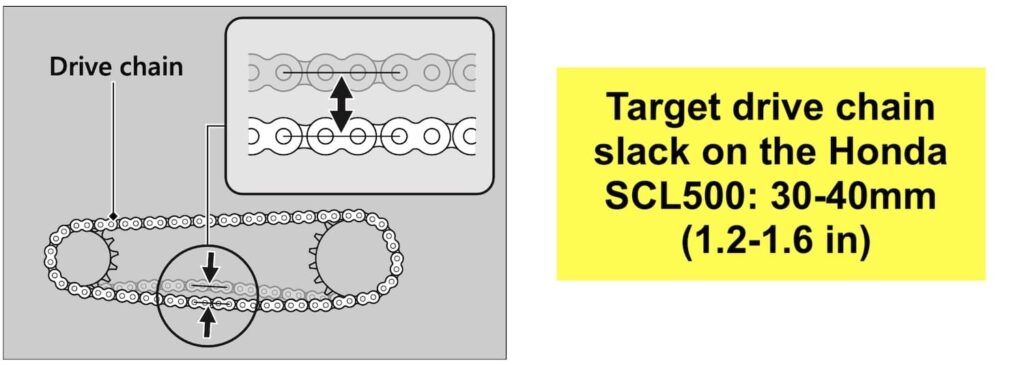
Target chain slack for the SCL500 / CL500: 30 – 40 mm (1.2 – 1.6 in)
If the chain is too loose, tighten it up with this procedure:
Adjusting Chain Slack
The manual doesn’t give a procedure for adjusting the drive chain slack for the Honda SCL500, so the below procedure should be useful. The torque spec is the same as on other similar motorcycles from Honda, e.g. the Honda CB500F.
As with measuring chain slack, make sure that the motorcycle is on a level surface on its kickstand, in neutral, with no weight on it (no saddlebags / luggage).
- Loosen the rear axle and the adjuster lock nuts on either side of the axle.
- Turn the adjuster nuts to tighten (or loosen) the chain. Keep checking the chain tension to see if it has come within spec.
- Keep an eye on the adjuster alignment marks on either side of the axle. Make sure that the adjustment is to the same point.
- When you’re done, tighten the axle to 88 Nm / 65 lb-ft, and the lock nuts to 21 Nm / 15 lb-ft.
- Re-check the chain slack again to make sure it’s still within spec.
Setting Rear Spring Preload on the Honda SCL500 / CL500
To adjust the preload of the rear suspension, you need the pin spanner provided in the toolkit.
Set the pin spanner on the rear shock at the base, and adjust the preload to one of five positions, as shown in the image.
This is an important thing to do even when test-riding, as the preload will affect how the bike handles.
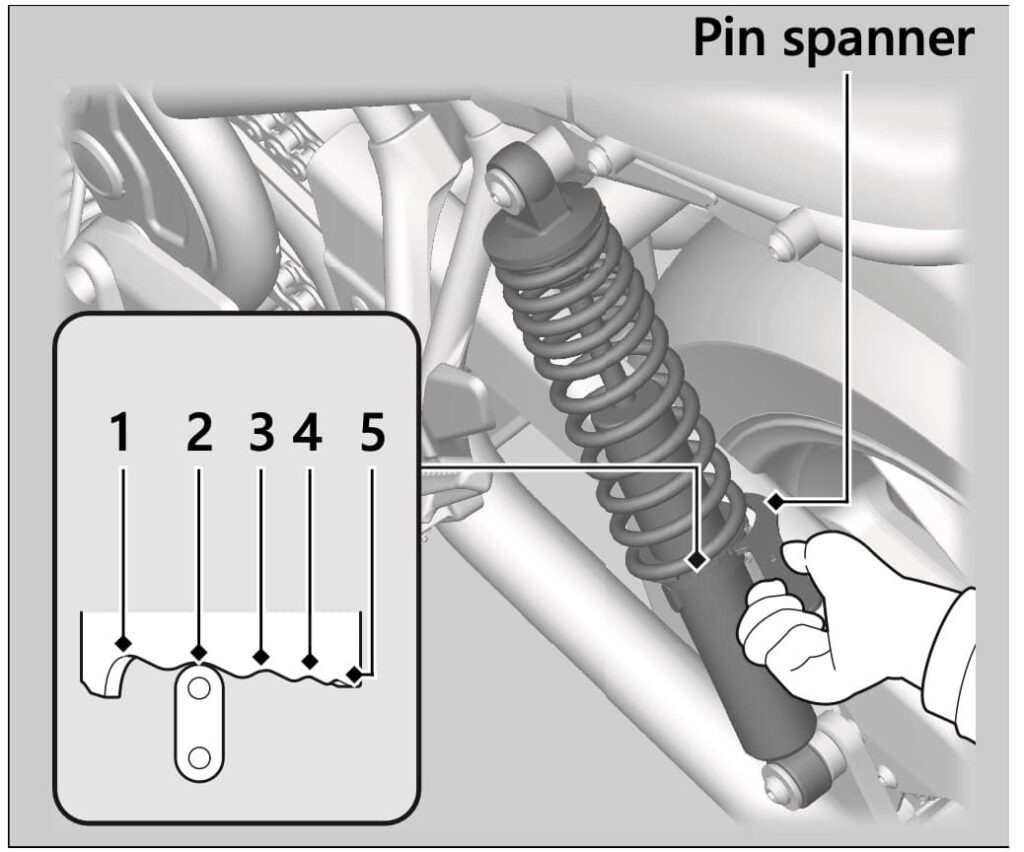
Honda SCL500 Suspension adjustment notes:
- The pin spanner is in the included tool kit (under the seat).
- Position 1 is softest, position 5 is hardest.
- Position 2 is the default.
- Give the suspension a jiggle between settings. Moving directly from 1 to 5 or 5 to 1 may damage the shock, per Honda’s manual.
Wheels and Tire pressures
The Honda SCL500 / CL500 runs a 19/17 inch front and rear wheel size, with block-pattern Dunlop Mixtour tires, ready to take you adventuring! (In the vicinity, anyway.)
| Wheel | Tire size | Tire pressure (cold) |
|---|---|---|
| Front | 110/70-R19 M/C 59H | 200 kPa / 2 bar / 29 psi |
| Rear | 150/70-R17 M/C 69H | 250 kPa / 2.5 bar / 36 psi |
About the Honda SCL500 / CL500
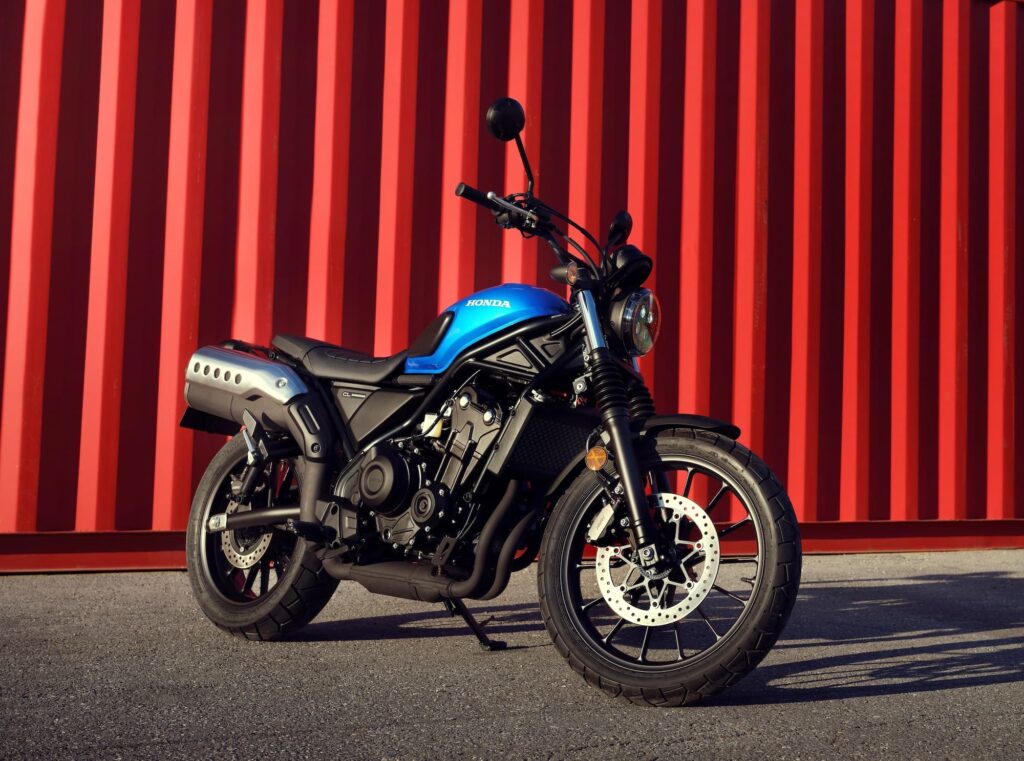
It took a while for Honda to get to the modern Scrambler craze, reignited most recently by the Ducati Scrambler, but they’ve finally done it with the Honda CL500, though they’ve called it the SCL500 in the US.
Actually, anyone with a very long memory (or the internet) would note that Honda had been making “Scrambler” style motorcycles long before they became fashionable. On top of that, Honda has been making adventure-style motorcycles since the 1980s, and still has class-leaders in the segment.
But it’s making a cosmetic scrambler — one not actually intended to be an off-road weapon — that’s new for Honda. And that’s what the Honda CL500 is.
At its heart, the Honda SCL500 / CL500 is essentially a Honda Rebel 500 (CMX500 Rebel) in very different clothing, and with some different components. The CL500 is based on the same 471-cc parallel twin and performs in much the same way, but has slightly more suspension travel, and and up-swept exhaust.
The Honda SCL500 / CL500 is designed to compete with other modestly-powered lightweight road bikes, like the Royal Enfield Interceptor 650 for example.
But where the SCL500 / CL500 differentiates itself from other scramblers with that motor. The 471cc twin has a reputation for near indestructibility. It’s mildly tuned with a 10.7:1 compression ratio, making a modest 34.3 kW at 8500 rpm, which makes it actually ideal for low-speed work. Scramblers and off-road were traditionally based on single-cylinder engines for a variety of reasons — keeping them light weight, focusing on low-end torque, and maintaining a reliable, easy-to-maintain design.
But the parallel twin motor in the SCL500 / CL500 achieves a lot of this. It’s light weight, produced lots of low down torque, and has a reputation for reliability that’s almost… unparalleled. (Ed: Ha, ha… I’ll see myself out)
A few points of differentiation versus the other motorcycles in the 500-series are:
- The Honda SCL500 / CL500 has a 41-tooth rear sprocket, vs 40 used by the Honda Rebel 500, to help it produce a little extra low-down pull.
- The front brake has only one disc, vs the twin discs in most of the 2022+ CB line-up, and only a two-piston sliding caliper. This isn’t a sportbike-spec brake setup.
- The rear subframe is designed to easily fit cosmetic parts, a rear rack / box, and/or panniers
The Honda SCL500’s dash / cluster and control set is a nice place to be. There’s an attractive LCD with Honda’s almost trademark blue glow.
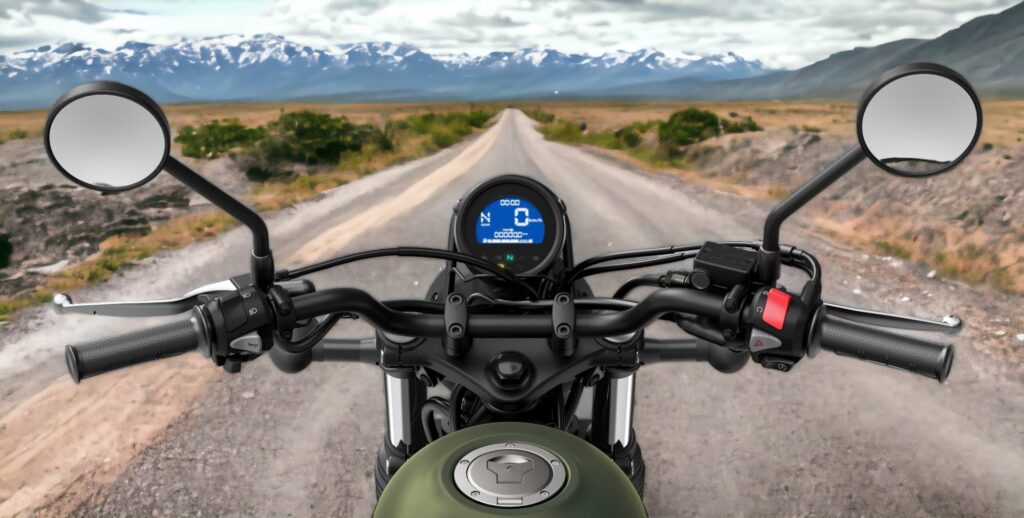
Lastly, the Honda SCL500 / CL500 does have ABS, and while it’s not switchable, it’s optimised for a variety of surfaces, including light off-road work.
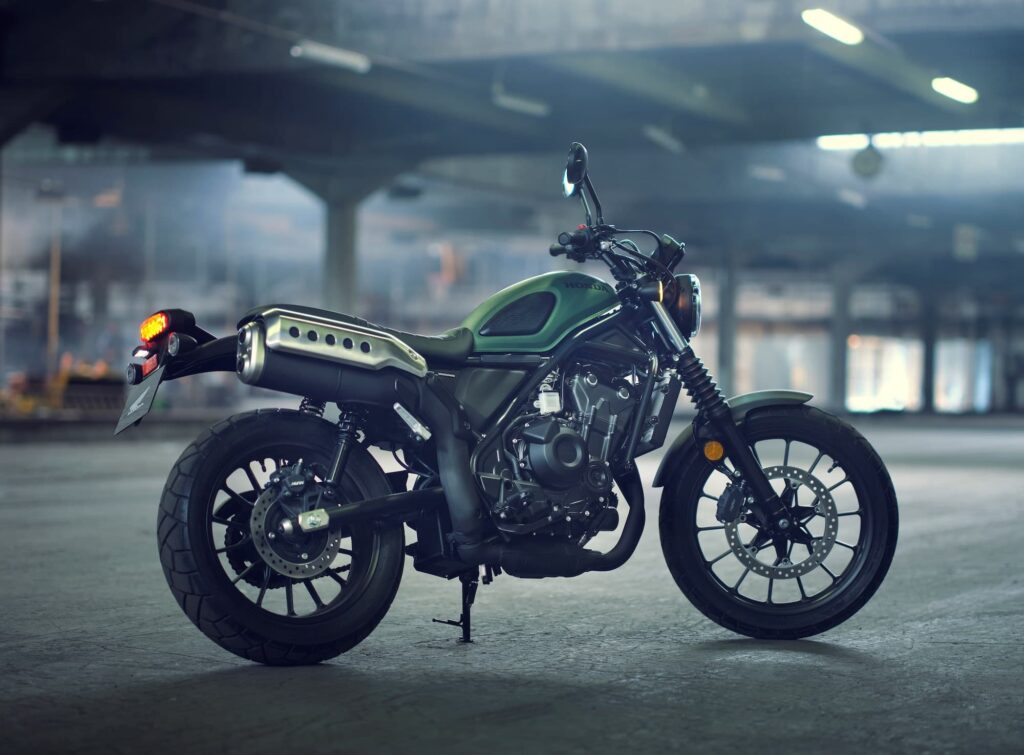
Reference — Honda SCL500 / CL500 Owner’s Manual
The above information came from the owner’s manual for the Honda SCL500 / CL500. See the below screenshots for reference.
The schedule for the SCL500 / CL500 is a little different from the rest of the 500-class motorcycles, recommending more frequent replacement of the air cleaner, for example.
You can get manuals for Honda motorcycles directly from Honda Europe.
The USA manual is available from here.

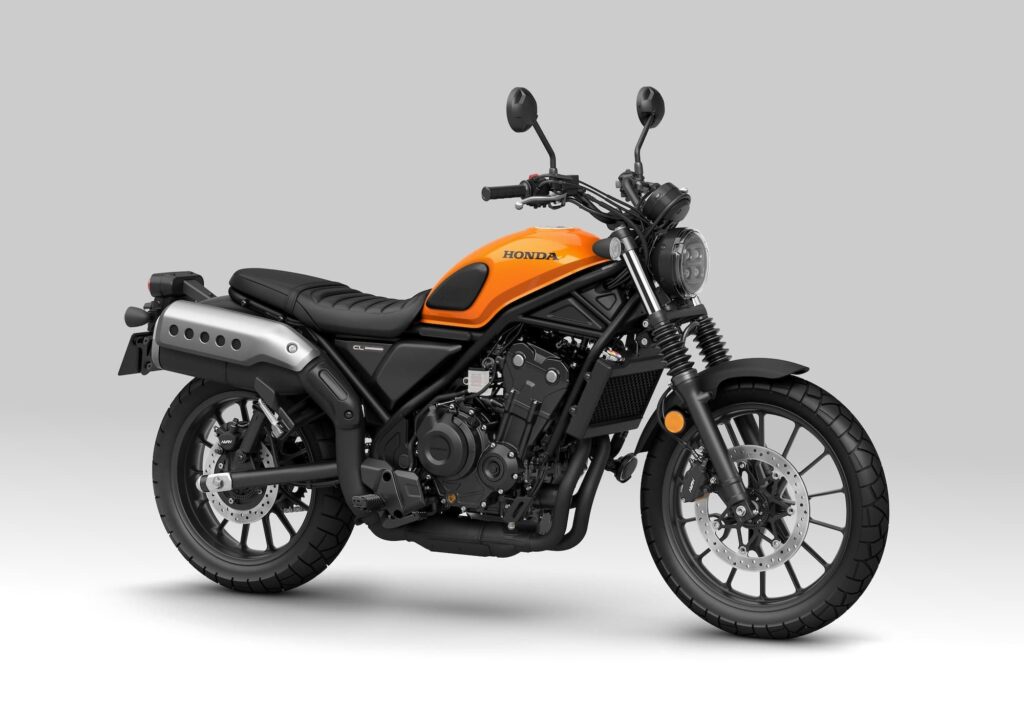
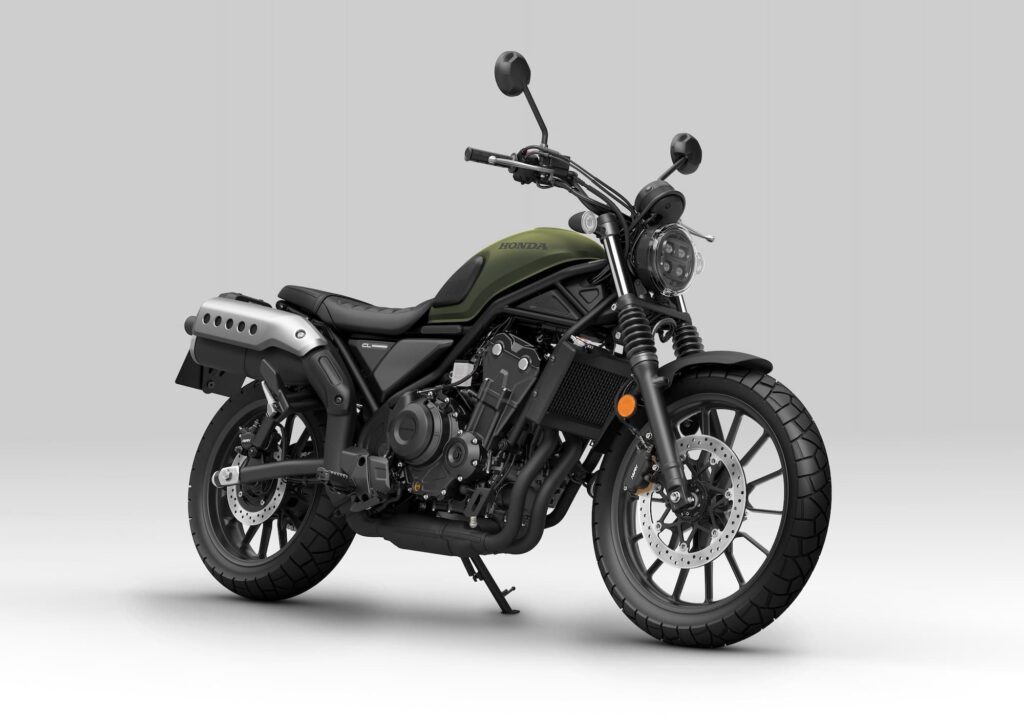
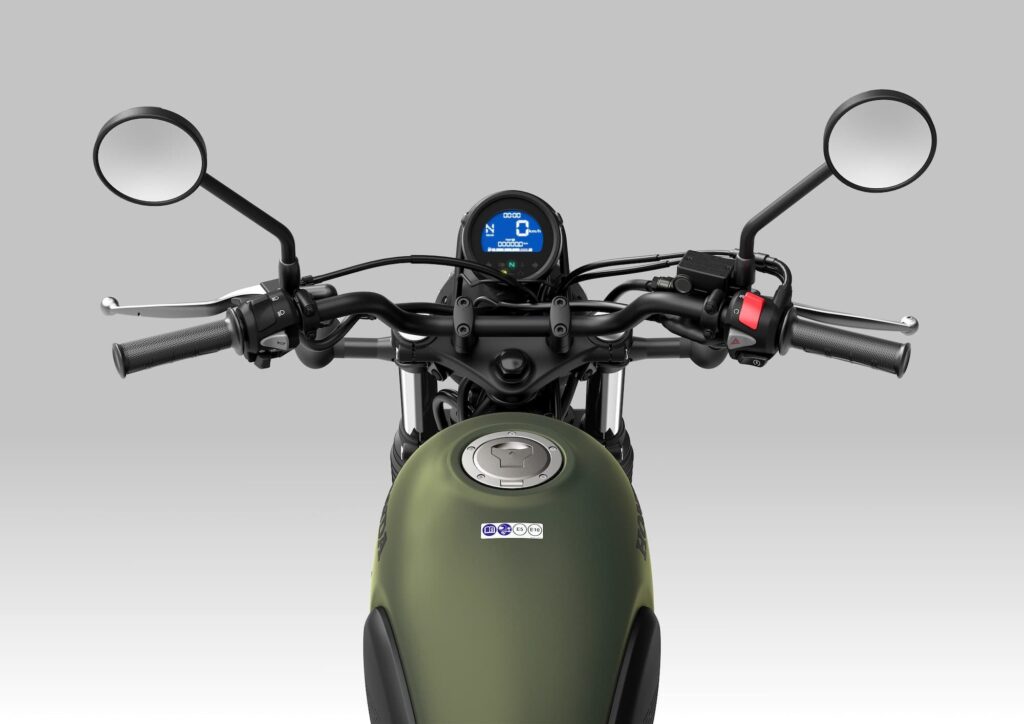
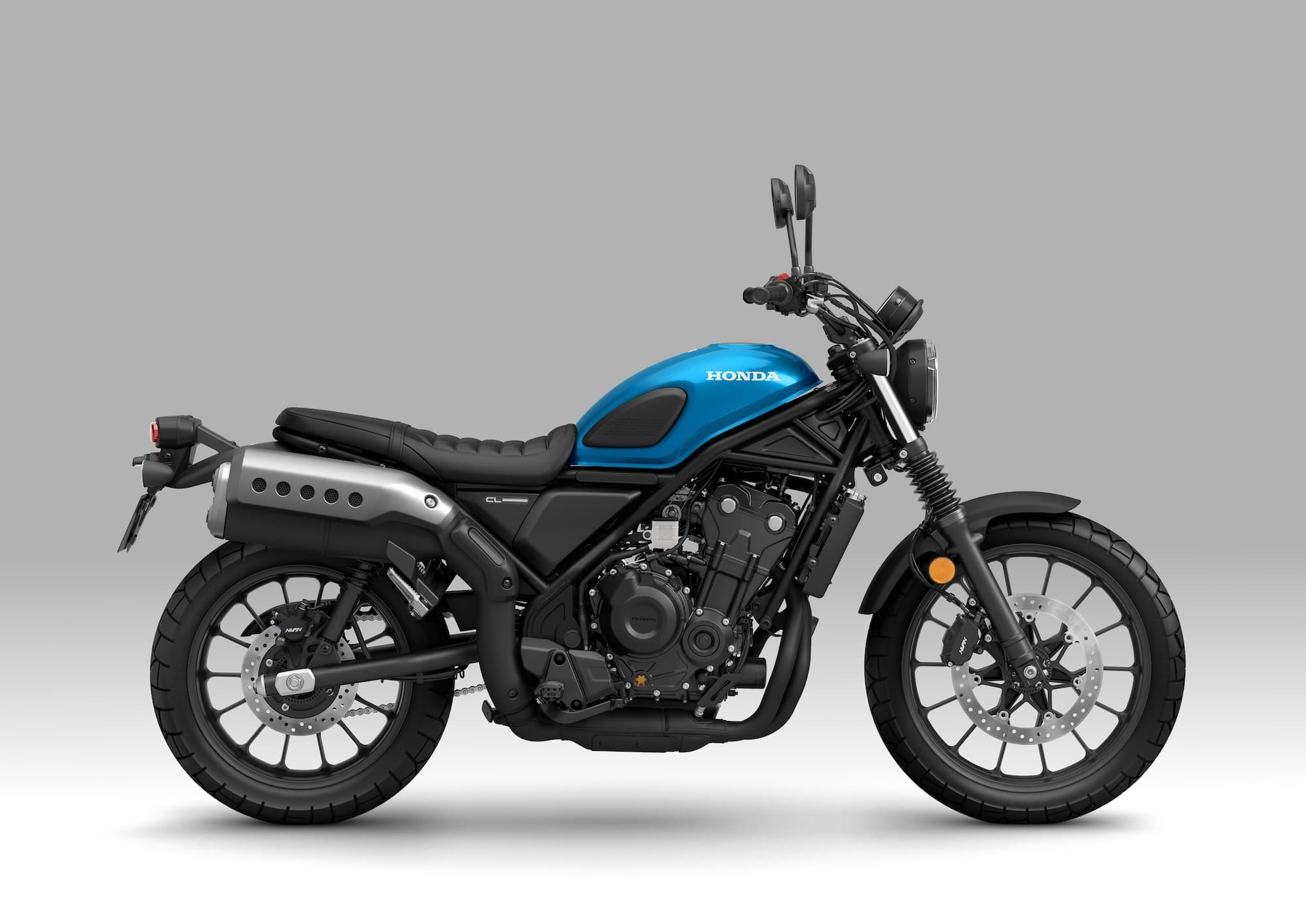
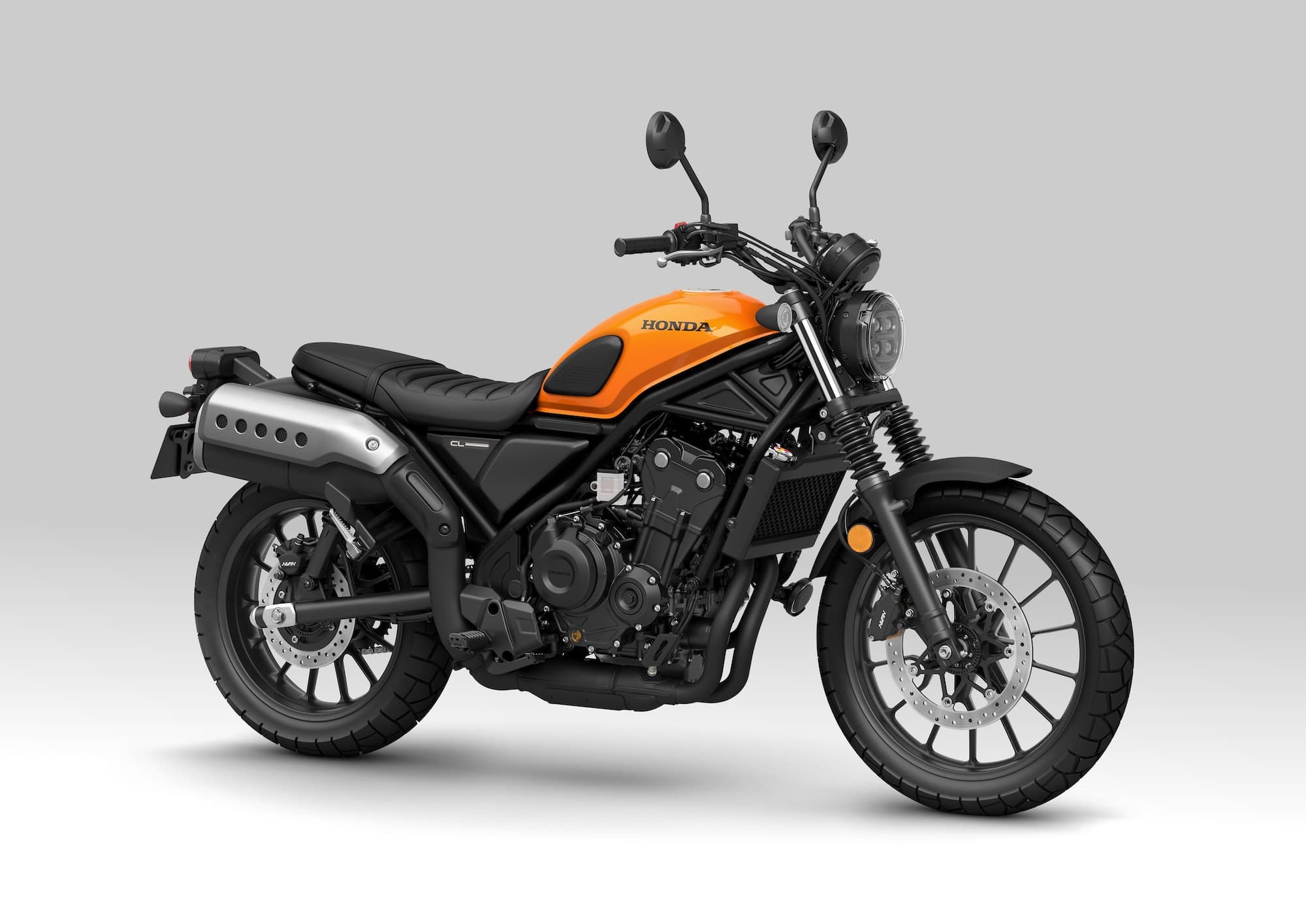
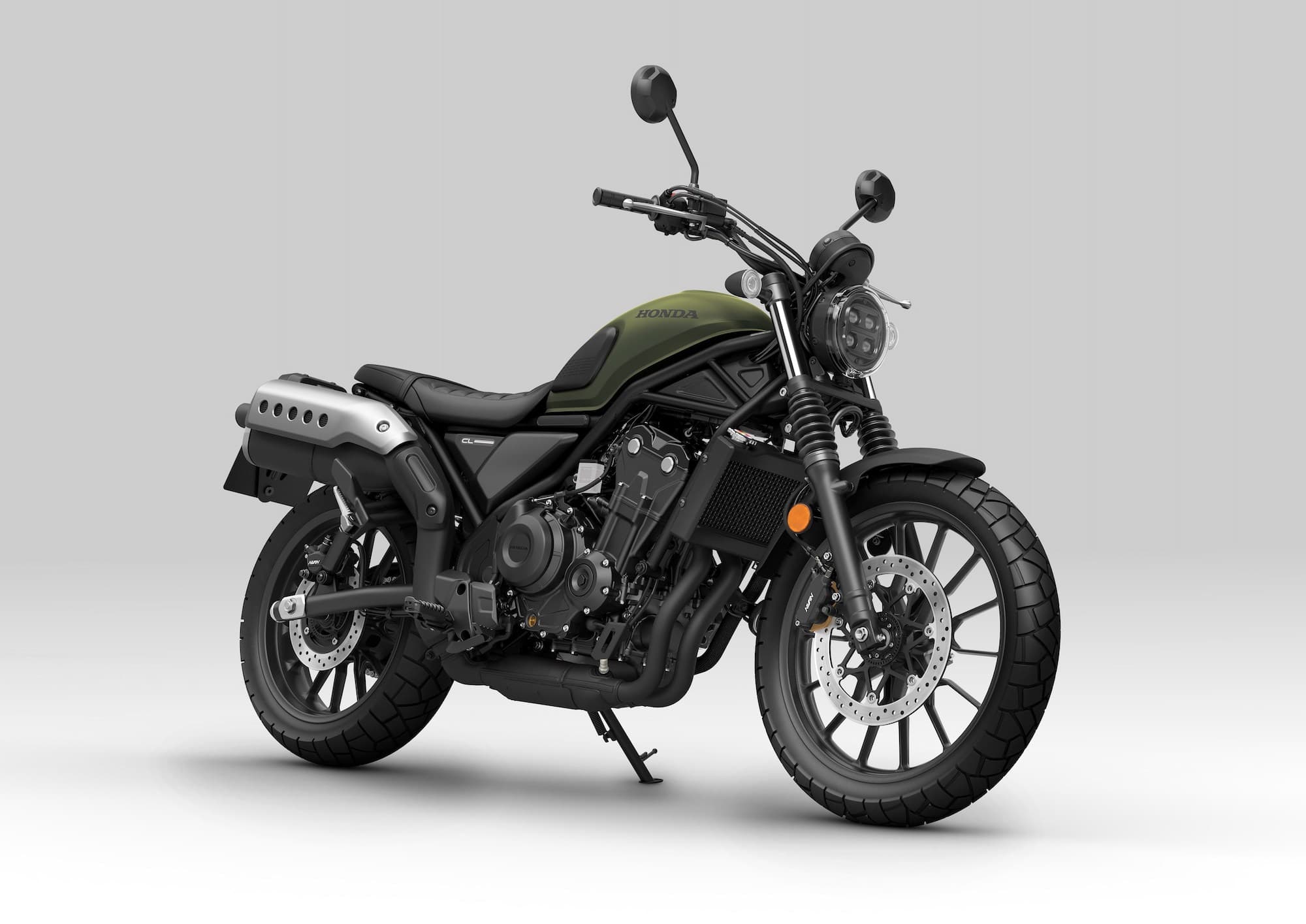
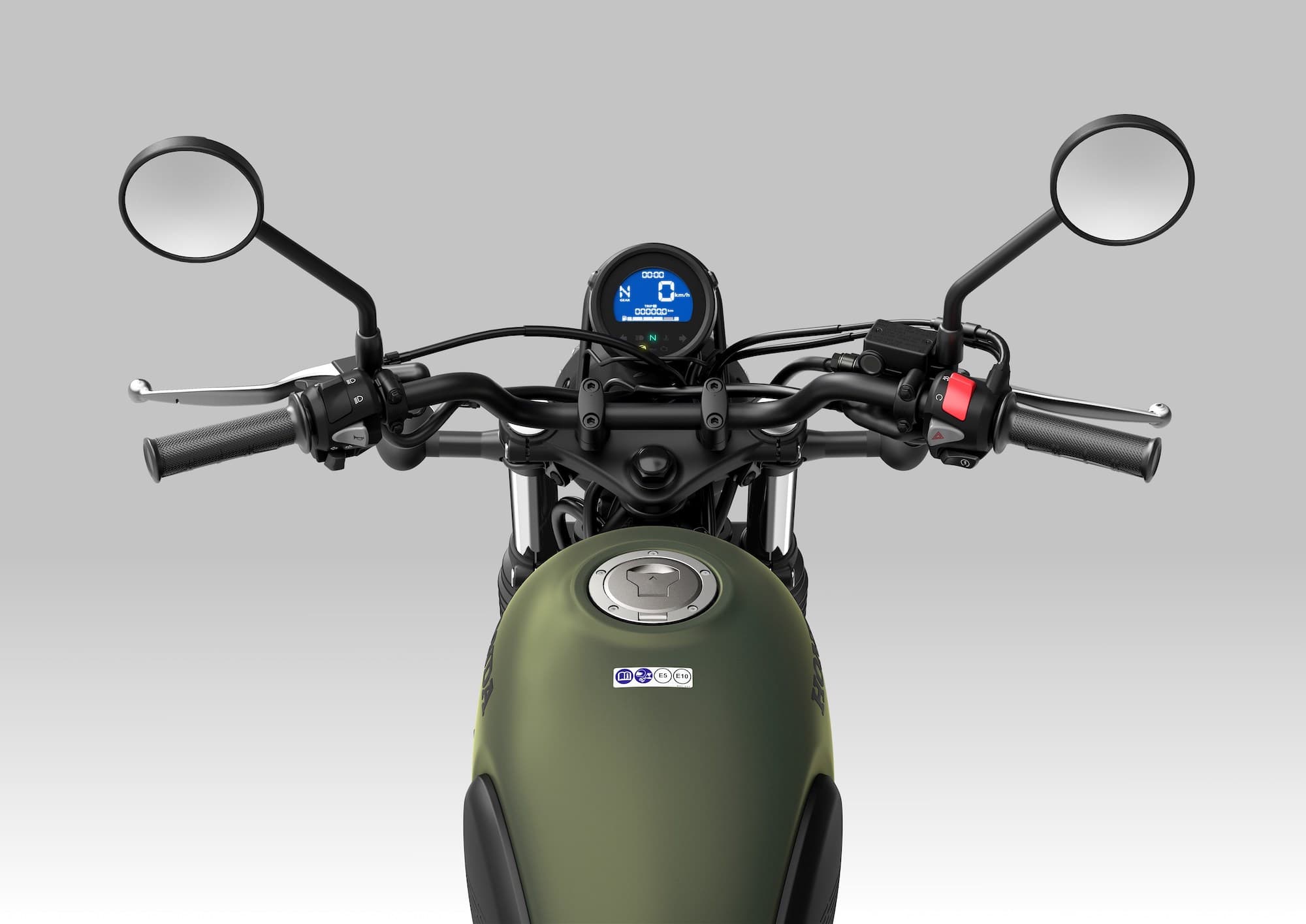
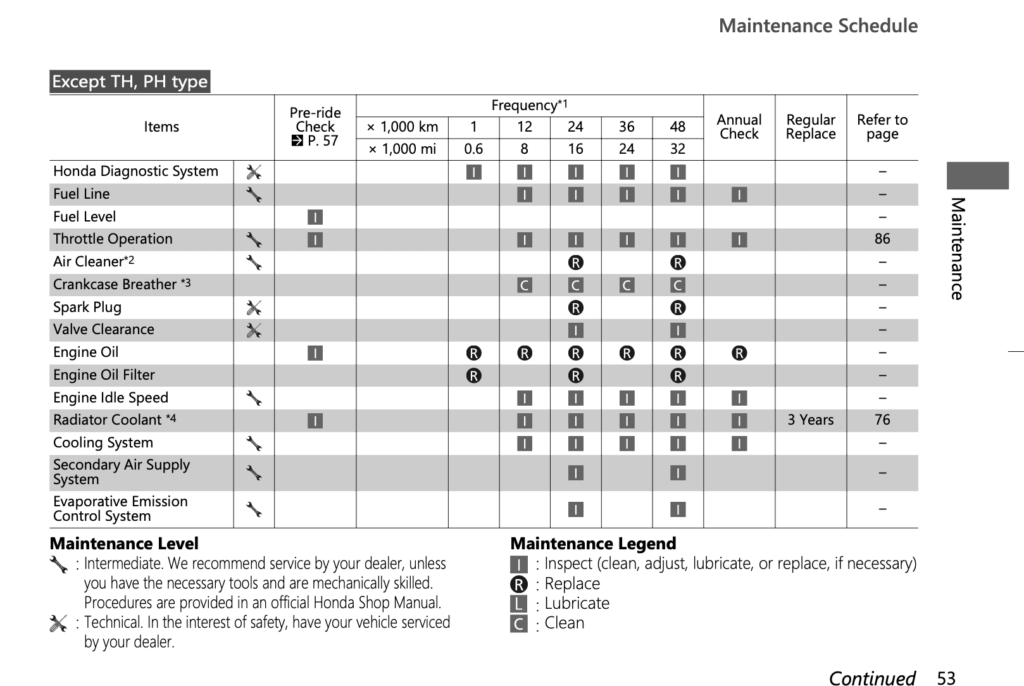
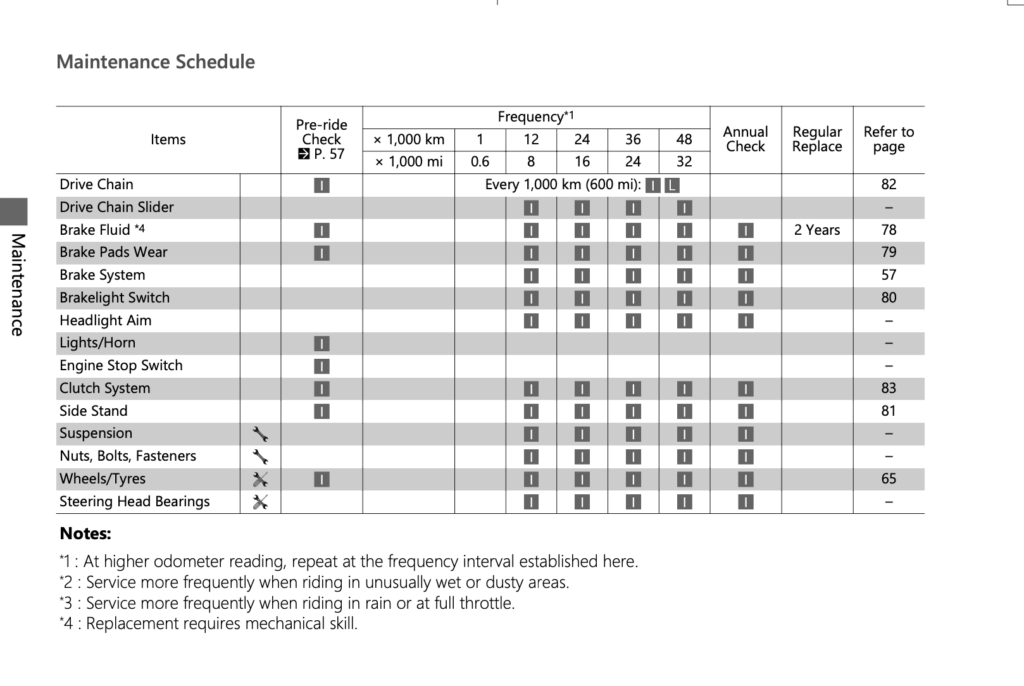
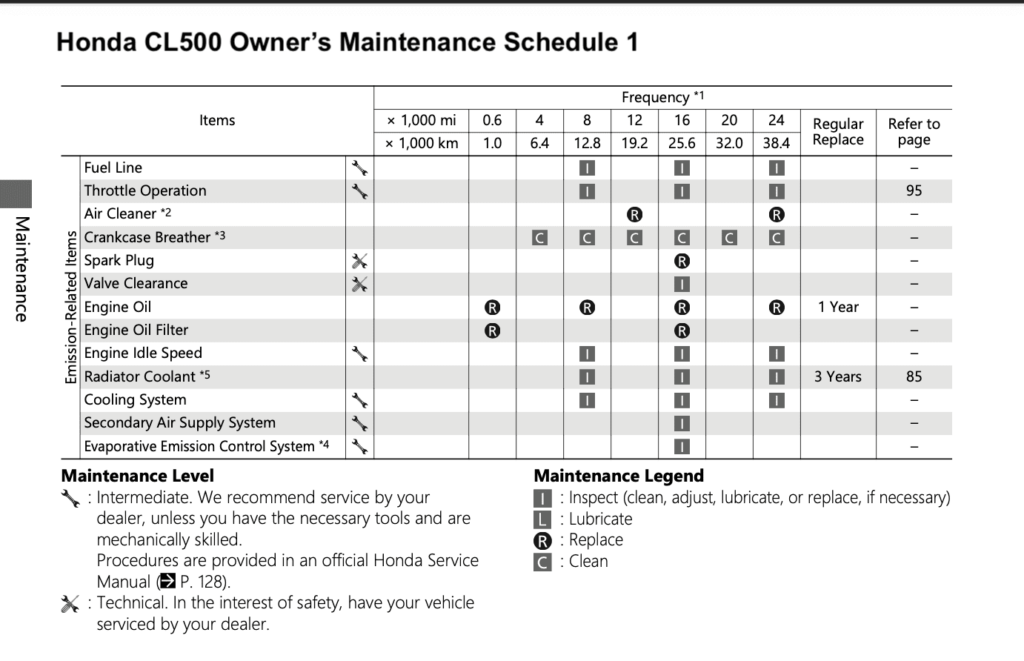
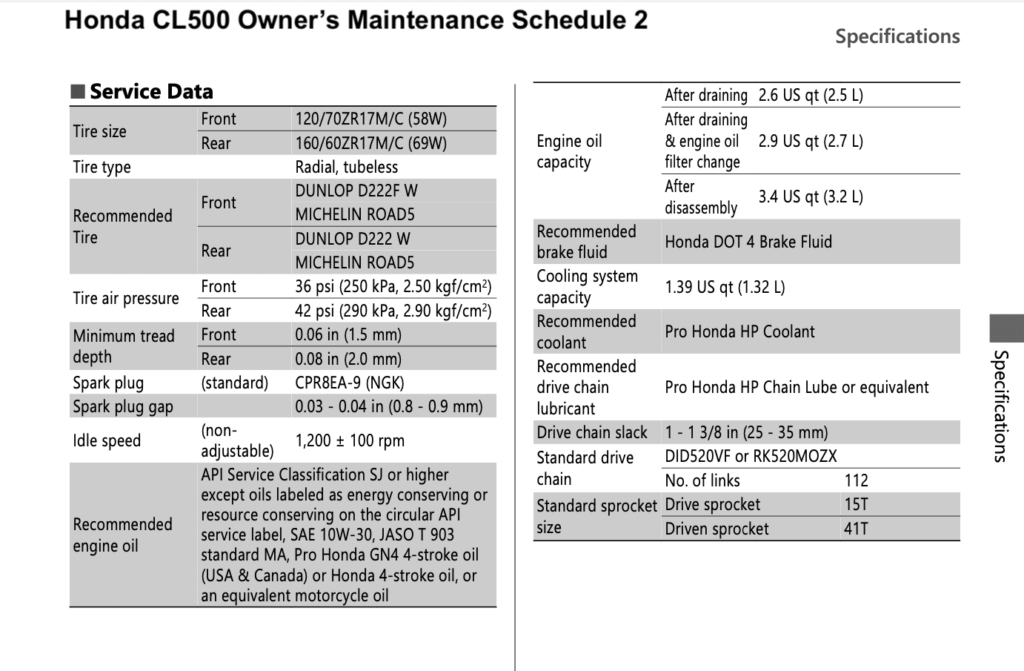
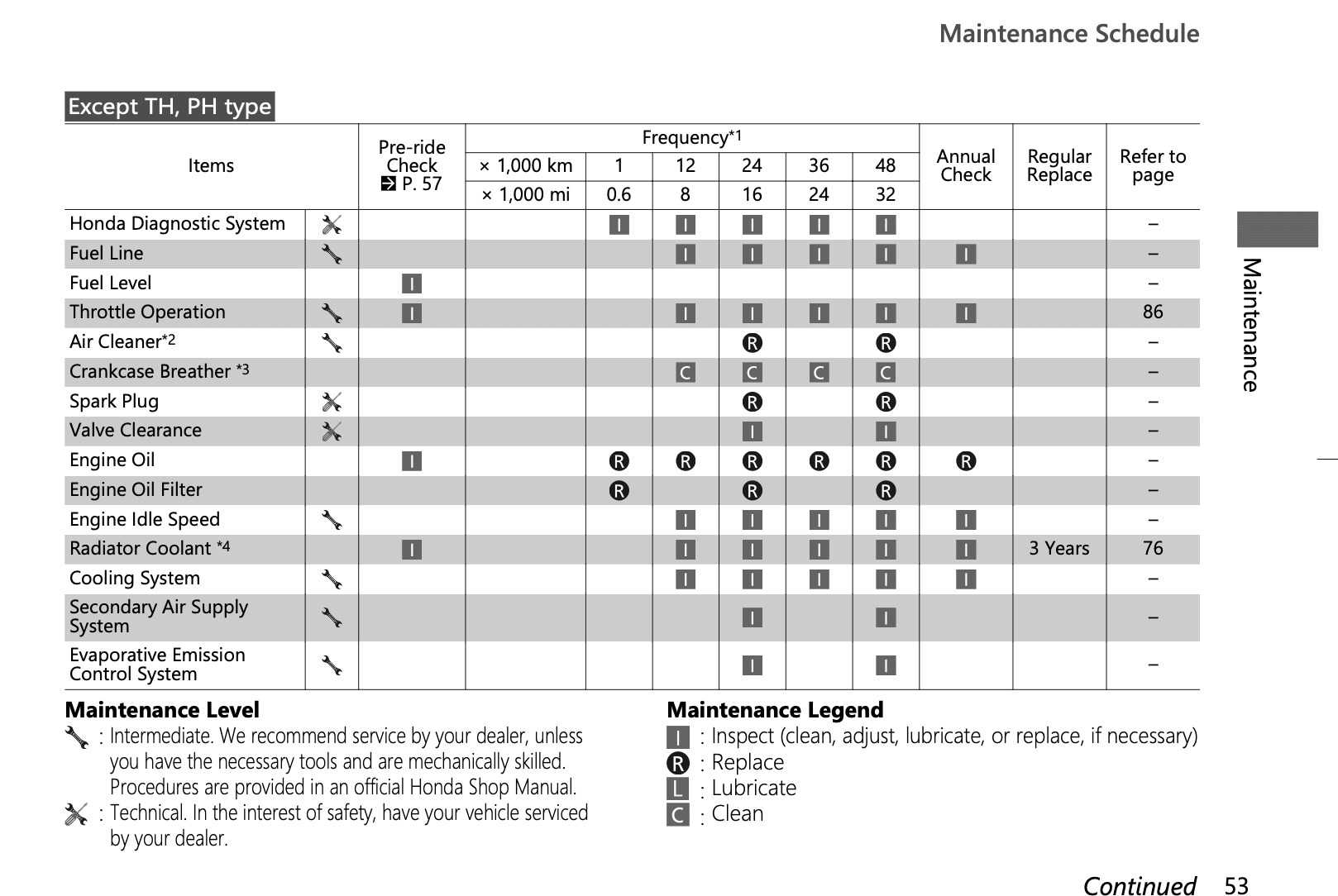
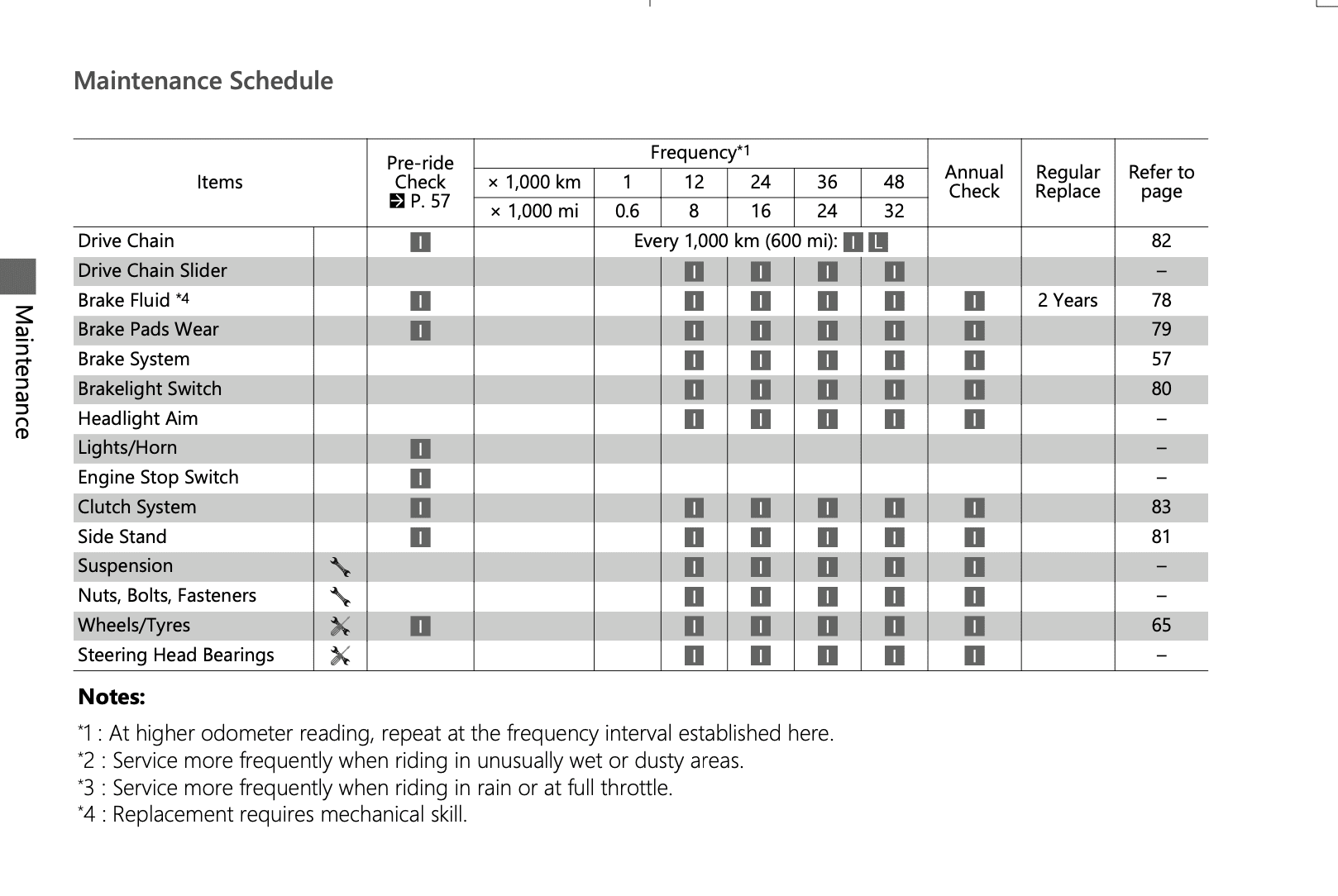
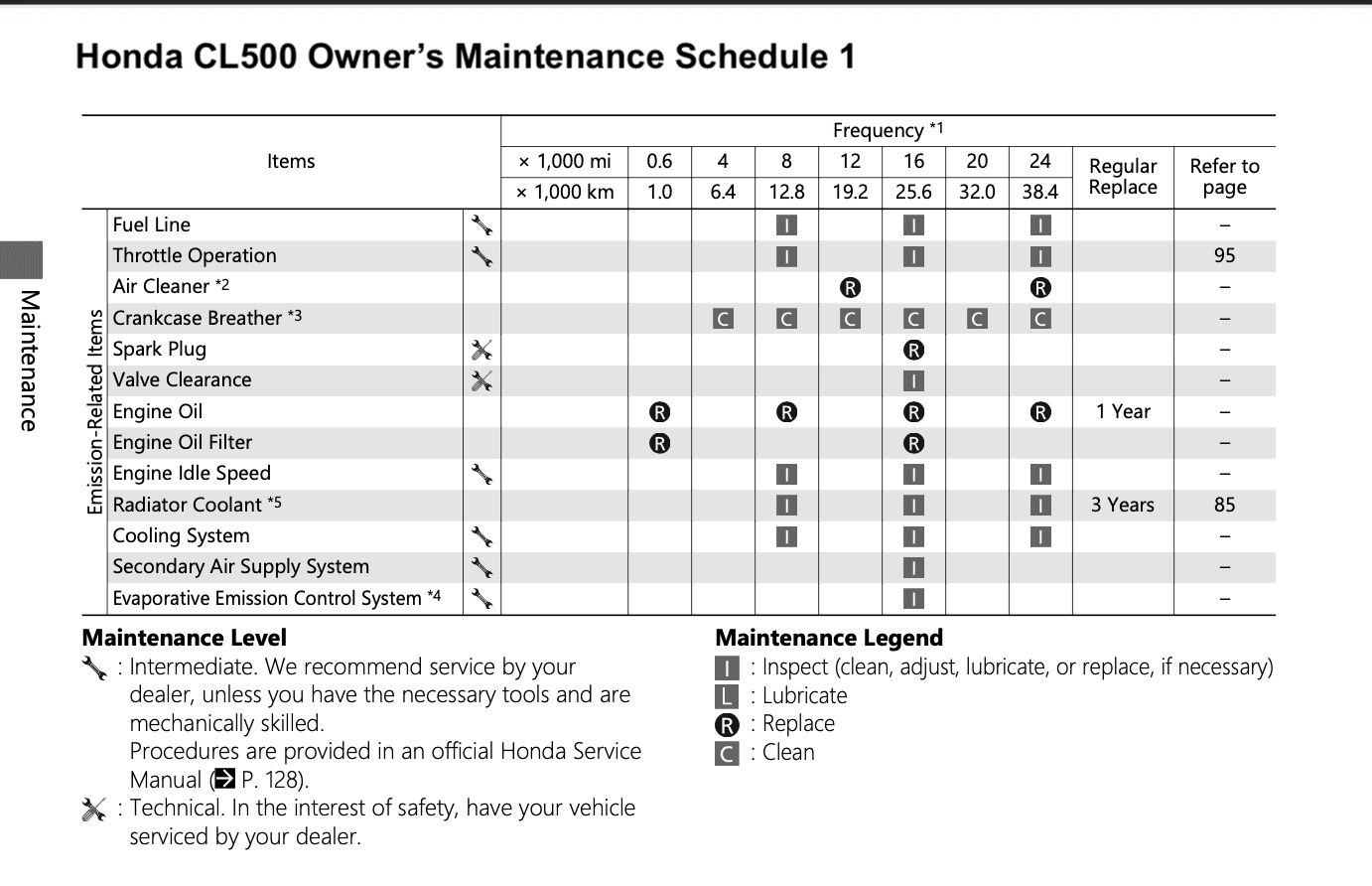
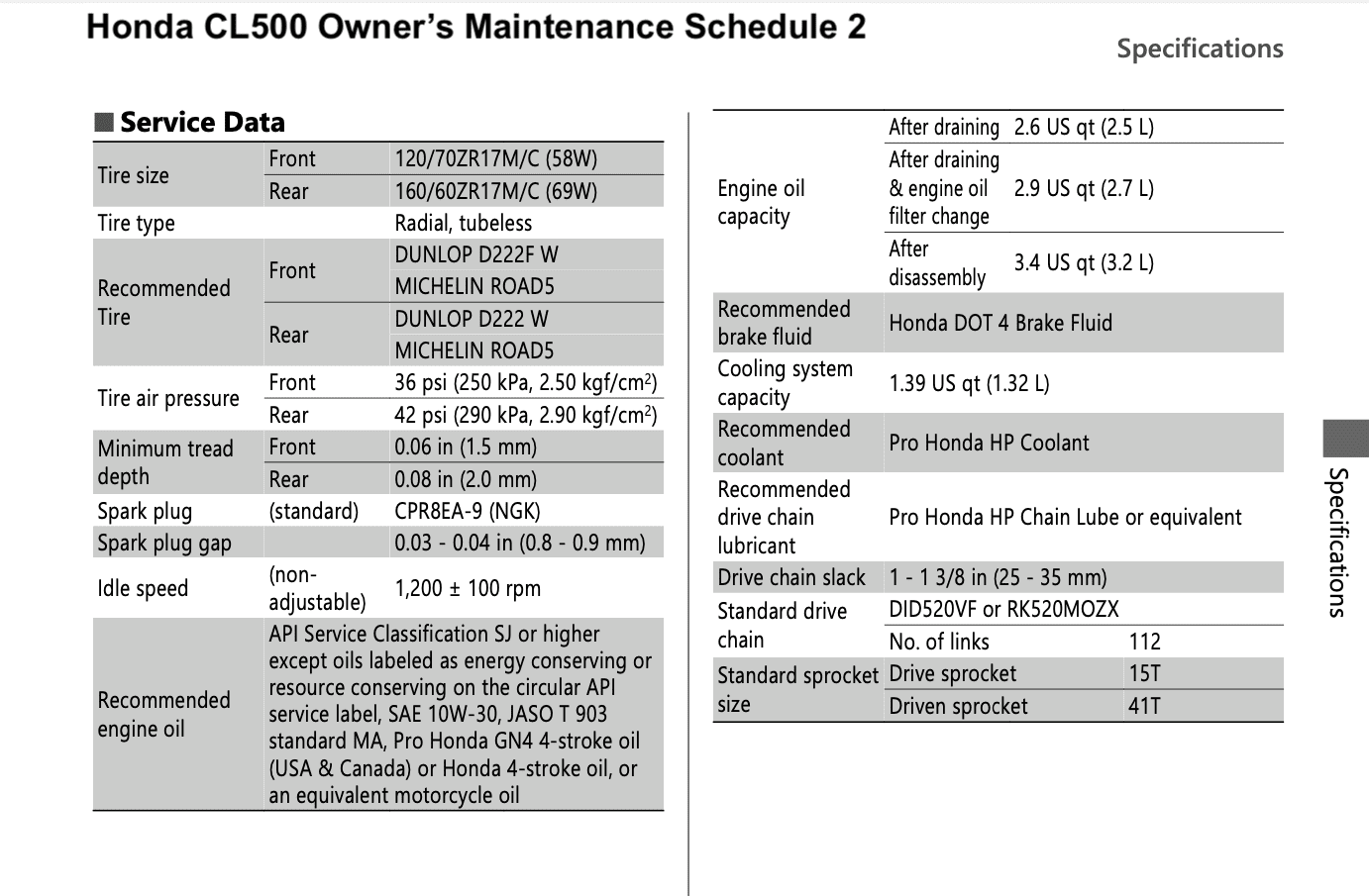
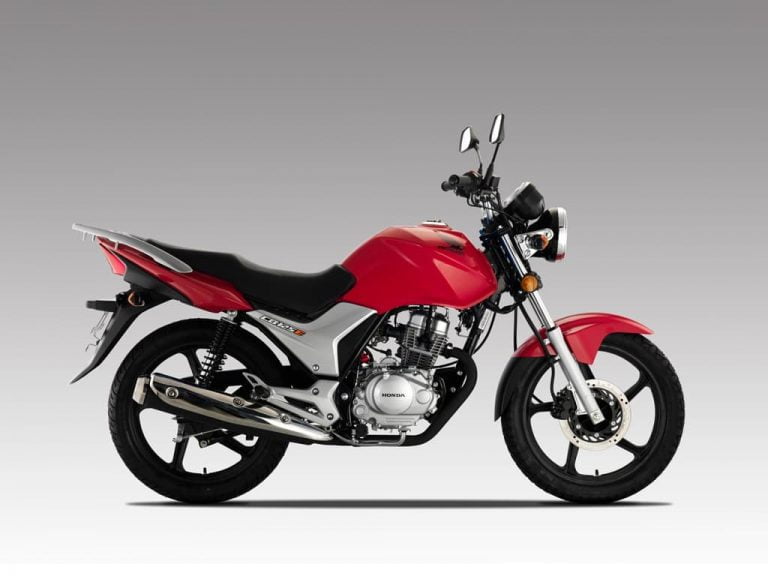
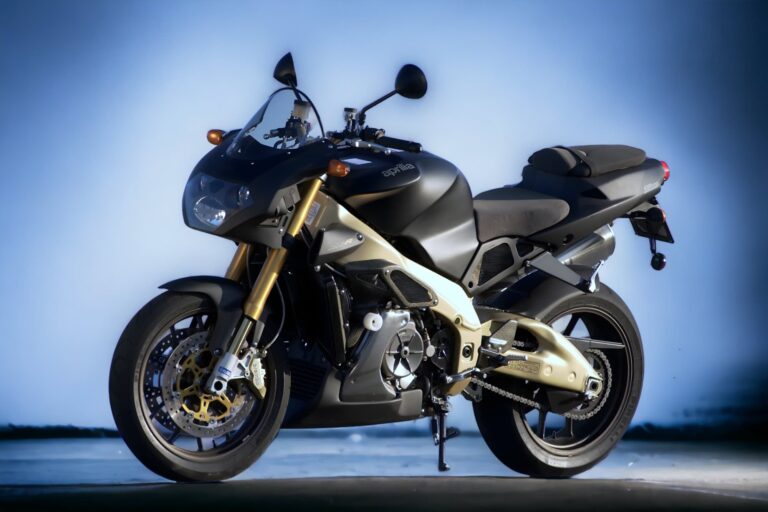

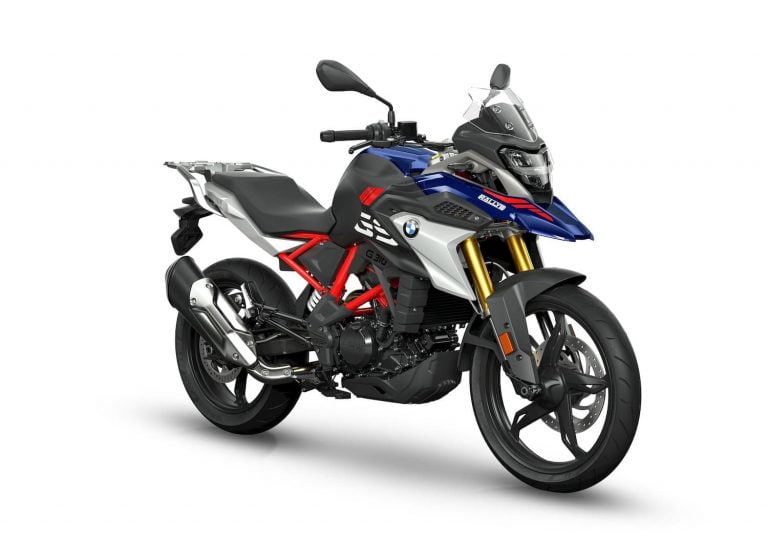


Hi the air filter listed is incorrect.
Thanks, good catch. Updated to the correct one, the HA-2513.